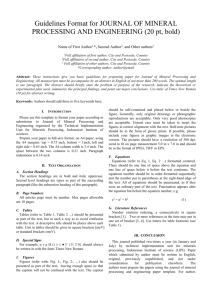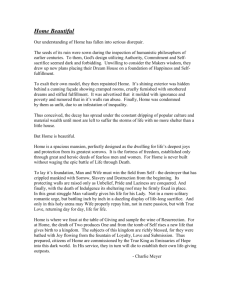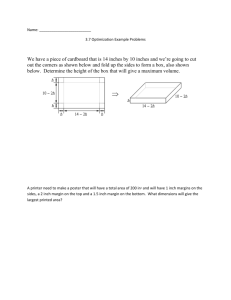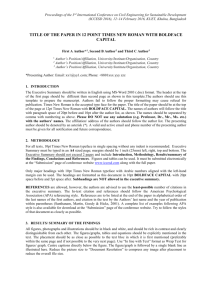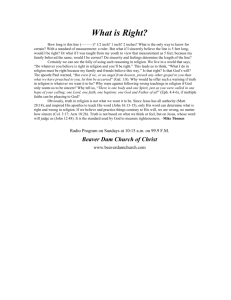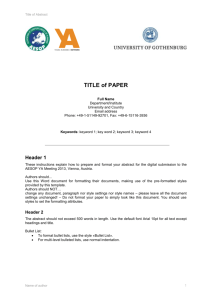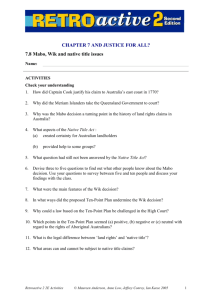Artificial Life 9 Proceeding Author Instructions
advertisement
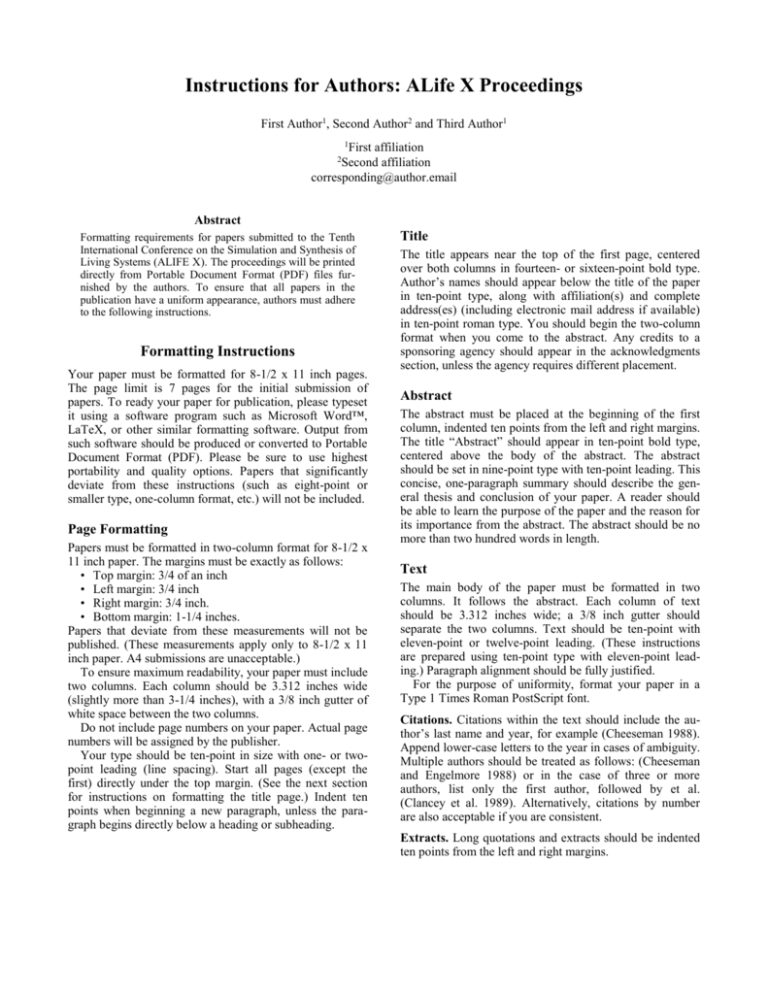
Instructions for Authors: ALife X Proceedings First Author1, Second Author2 and Third Author1 1 First affiliation Second affiliation corresponding@author.email 2 Abstract Formatting requirements for papers submitted to the Tenth International Conference on the Simulation and Synthesis of Living Systems (ALIFE X). The proceedings will be printed directly from Portable Document Format (PDF) files furnished by the authors. To ensure that all papers in the publication have a uniform appearance, authors must adhere to the following instructions. Formatting Instructions Your paper must be formatted for 8-1/2 x 11 inch pages. The page limit is 7 pages for the initial submission of papers. To ready your paper for publication, please typeset it using a software program such as Microsoft Word™, LaTeX, or other similar formatting software. Output from such software should be produced or converted to Portable Document Format (PDF). Please be sure to use highest portability and quality options. Papers that significantly deviate from these instructions (such as eight-point or smaller type, one-column format, etc.) will not be included. Page Formatting Papers must be formatted in two-column format for 8-1/2 x 11 inch paper. The margins must be exactly as follows: • Top margin: 3/4 of an inch • Left margin: 3/4 inch • Right margin: 3/4 inch. • Bottom margin: 1-1/4 inches. Papers that deviate from these measurements will not be published. (These measurements apply only to 8-1/2 x 11 inch paper. A4 submissions are unacceptable.) To ensure maximum readability, your paper must include two columns. Each column should be 3.312 inches wide (slightly more than 3-1/4 inches), with a 3/8 inch gutter of white space between the two columns. Do not include page numbers on your paper. Actual page numbers will be assigned by the publisher. Your type should be ten-point in size with one- or twopoint leading (line spacing). Start all pages (except the first) directly under the top margin. (See the next section for instructions on formatting the title page.) Indent ten points when beginning a new paragraph, unless the paragraph begins directly below a heading or subheading. Title The title appears near the top of the first page, centered over both columns in fourteen- or sixteen-point bold type. Author’s names should appear below the title of the paper in ten-point type, along with affiliation(s) and complete address(es) (including electronic mail address if available) in ten-point roman type. You should begin the two-column format when you come to the abstract. Any credits to a sponsoring agency should appear in the acknowledgments section, unless the agency requires different placement. Abstract The abstract must be placed at the beginning of the first column, indented ten points from the left and right margins. The title “Abstract” should appear in ten-point bold type, centered above the body of the abstract. The abstract should be set in nine-point type with ten-point leading. This concise, one-paragraph summary should describe the general thesis and conclusion of your paper. A reader should be able to learn the purpose of the paper and the reason for its importance from the abstract. The abstract should be no more than two hundred words in length. Text The main body of the paper must be formatted in two columns. It follows the abstract. Each column of text should be 3.312 inches wide; a 3/8 inch gutter should separate the two columns. Text should be ten-point with eleven-point or twelve-point leading. (These instructions are prepared using ten-point type with eleven-point leading.) Paragraph alignment should be fully justified. For the purpose of uniformity, format your paper in a Type 1 Times Roman PostScript font. Citations. Citations within the text should include the author’s last name and year, for example (Cheeseman 1988). Append lower-case letters to the year in cases of ambiguity. Multiple authors should be treated as follows: (Cheeseman and Engelmore 1988) or in the case of three or more authors, list only the first author, followed by et al. (Clancey et al. 1989). Alternatively, citations by number are also acceptable if you are consistent. Extracts. Long quotations and extracts should be indented ten points from the left and right margins. This is an example of an extract or quotation. Note the indent on both sides. Quotation marks are not necessary if you offset the text in a block like this, and properly identify and cite the quotation in the text. Footnotes. Avoid footnotes as much as possible; they interrupt the reading of the text. When essential, they should be consecutively numbered throughout with superscript Arabic numbers. Footnotes should appear at the bottom of the page, separated from the text by a blank line space and a thin, half-point rule.1 Figures Figures, drawings, tables, and photographs should be placed throughout the paper near the place where they are first discussed. Do not group them together at the end of the paper. If placed at the top or bottom of the paper, illustrations may run across both columns. Figures must not invade the top, bottom, or side margin areas. Insert figures using your page-formatting software. Number figures sequentially, for example, figure 1, and so on. The illustration number and caption should appear under the illustration. Leave some space between the figure and the caption and surrounding type; 1/4 inch should suffice. Captions, labels, and other text in illustrations must be at least nine-point type. Headings and Sections When necessary, headings should be used to separate major sections of your paper. An overabundance of headings will tend to make your paper look more like an outline than a paper. First-level heads should be twelve-point bold type, mixed case (initial capitals followed by lower case on all words except articles, conjunctions, and prepositions, which should appear entirely in lower case), with fifteenpoint leading, centered, with one blank line preceding them and three additional points of leading following them. Second-level headings should be eleven-point bold type, mixed case, with thirteen-point leading, flush left, with one blank line preceding them and three additional points of leading following them. Do not skip a line between paragraphs. Third-level headings should be run in with the text, tenpoint bold type, mixed case, with twelve-point leading, flush left, with six points of additional space preceding them and no additional points of leading following them. Sections should be arranged and headed as follows: Acknowledgments. The acknowledgments section, if included, appears after the main body of text and is headed “Acknowledgments.” This section includes acknowledgments of help from associates and colleagues, credits to sponsoring agencies, financial support, and permission to publish. Please try to limit acknowledgments to no more than three sentences. 1 This is an example of a footnote. Use sparingly! Appendices. Any appendices follow the acknowledgments (if included or after the main body of text if no acknowledgments appear). References. The references section should be labeled “References” and should appear at the end of the paper. A sample list of references is given at the end of these instructions. Please use a consistent format for references. Poorly prepared or sloppy references reflect badly on the quality of your paper and your research. Please prepare complete and accurate citations. Preparing Electronic Version of Your Paper Papers must be submitted in Portable Document Format, and delivered using the web-based submission form provided at www.alife9.org (do not email papers). PDF files may be created using Adobe Systems Inc.’s PDFWriter or converted from postscript to PDF using Distiller or a similar product. If you do not have suitable PDF creation software, limited free conversion is provided here: https://createpdf.adobe.com, and many other free Word to PDF and Postscript to PDF converters can be found on-line (e.g. http://docmorph.nlm.nih.gov/docmorph/). Unix/Linux conversion can be performed with the ps2pdf command. Useful information for controlling the appearance of fonts in LaTeX may be found in Kendall Whitehouse’s “Creating Quality Adobe PDF Files from TeX with DVIPS” (see e.g. http://frank.harvard.edu/~coldwell/dvipspdf.html) and for creating PDF from Word, the information at Adobe Systems Inc.’s web site (http://www.adobe.com/support/techdocs/f8be.htm) may be useful. Style Files and Templates As a courtesy to authors, we have created generic templates and style files that can be used to format two-column camera copy. (Please read the formatting instructions!) You can retrieve these templates via www.alife9.org. From this point, you should be able to follow the links to the specific information you require. The style files and templates have been tested only on a limited number of devices. They are therefore provided “as is” without any guarantee that they will work on your particular machine. If you are having trouble with the macros or templates, we suggest you contact an expert who is familiar with the particular hardware and software environment at your site for assistance. Inquiries If you have any questions about the preparation or submission of your paper as instructed here, please email submissions@alife10.org References Book with Multiple Authors Engelmore, R., and Morgan, A. eds. 1986. Blackboard Systems. Reading, Mass.: Addison-Wesley. Journal Article Robinson, A. L. 1980a. New Ways to Make Microcircuits Smaller. Science 208:1019-1026. Magazine Article Hasling, D. W.; Clancey, W. J.; and Rennels, G. R. 1983. Strategic Explanations in Consultation. The International Journal of Man-Machine Studies 20(1):3–19. Proceedings Paper Clancey, W. J. 1983b. Communication, Simulation, and Intelligent Agents: Implications of Personal Intelligent Machines for Medical Education. In Proceedings of the Eighth International Joint Conference on Artificial Intelligence, 556-560. Menlo Park, Calif.: International Join Conferences on Artificial Intelligence, Inc. University Technical Report Rice, J. 1986. Poligon: A System for Parallel Problem Solving, Technical Report, KSL-86-19, Dept. of Computer Science, Stanford Univ. Dissertation or Thesis Clancey, W. J. 1979b. Transfer of Rule-Based Expertise through a Tutorial Dialogue. Ph.D. diss., Dept. of Computer Science, Stanford Univ. Forthcoming Publication Clancey, W. J. 1986a. The Engineering of Qualitative Models. Forthcoming. This document was last revised on 1 Jan 2003.

